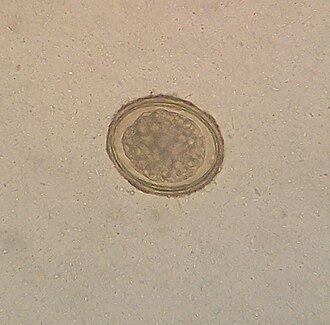Ascaris lumbricoides infestation
P.K. Ghatak, M.D.
Ascaris lumbricoides is a foot long intestinal parasite. The human infection has been known since ancient times. The first written record of human infection was given by Linnaeus in 1758.
Ascaris lumbricoides is a roundworm; the sexes are separate and the female worm is larger. Adult worms live in the small intestine of humans. Ascaris also infects pigs, monkeys and other animals. A female ascaris lives one to two years and can lay 200,000 eggs a day. The eggs are mostly fertile, but unfertilized eggs are also present in the stool of the victims. If a female worm does not find a male worm, it moves around, and crawls into the throat. If it enters the larynx, it causes respiratory distress and a bout of violent cough till it is dislodged. It may also come out of the nostrils.
People at risk:
The WHO says about 1 billion people are at risk of infection. The infective state of the worm is the fertilized 3rd stage eggs or embryonated eggs. Unlike any other parasite, ascaris eggs are well protected by their thick outer shell and can live for 3 years in the soil. People unknowingly swallow eggs carried on their fingers due to their unhygienic habits or ingestion of contaminated water and food. Humans and farm animals act as reservoirs of ascaris.
Life history of Ascaris:
The fertilized eggs are deposited in the soil, either by spraying the human waste on the agricultural land as fertilizer or by people defecating out in the open. The eggs undergo further development in the soil and become embryonated eggs in 15 -18 days.
Children playing in the dirt carry soil and eggs on their fingers or under their nails. The eggs enter the mouth when children eat with their fingers. The same way, adults are infected or, contaminated food and drinks by the food handlers.
Inside the duodenum, the larvae emerge. The larvae move to the lungs for further development. The larvae reach the lungs by way of the Portal vein and finally in the pulmonary circulation. In the lungs, the larvae become juvenile worms in about 15 days. The juvenile worms journey back to the small intestine by way of the trachea and are coughed up and swallowed by the victim. Back in the intestine, for the second time, they reach maturity and mate with the opposite sex and begin laying eggs in 3 months from the time of infection.
Researchers are not sure why ascariasis larvae must travel to the lungs. Several reasons are put forward but still remain unknown.
Human disease.
During initial infection. Most of the victims are unaware of infection and remain symptom free. Some develop abdominal cramps and diarrhea.
During migration to the lungs. This period is generally asymptomatic.
The period of stay in the lungs. Symptoms are mostly due to the physical presence of foreign bodies in the airways and all related pulmonary complications, secondary infections and allergic asthma with eosinophilia.
During migration from the lungs to the small intestine. Cough and the horror of live worms being coughed up.
Small intestinal stay. Though the worms do not suck blood like hookworm, nevertheless, they steal nutrients from the children and children become stunted and malnourished. Motile worms in the intestine can enter the bile duct, gall bladder, and appendix, causing acute obstruction and infection. A heavy parasitic load in the small intestine causes bowel obstruction.
During adult female searching for a male worm. When the worm reaches the pharynx and sometimes enters the larynx, cough and respiratory distress develop.
Diagnosis:
Fertilized ascaris eggs are diagnostic. Unfertilized eggs sink, while fertilized eggs float in water. Each egg is oval to round in shape, measuring 75 x 50 micrometers, and has a thick mamillated outer shell and is usually stained brown by bile.
Adult worms are also diagnostic. The worms are long, slender, cylindrical, unsegmented and colored light yellow. The mouth end is surrounded by 3 lips. The male worm is 30 cm long and 4 mm in diameter, and has a curved tail end. A female measures 40 cm (over a foot long) X 6 mm. The genital aperture is in the upper third of the body, and 2/3 of the body contains sacs containing 25 million eggs.
Treatment. Albendazole and Mebendazole are effective in killing the adult worms. A daily dose for 3 days is recommended for cure. Reinfections are common in endemic areas.
***************************************************


